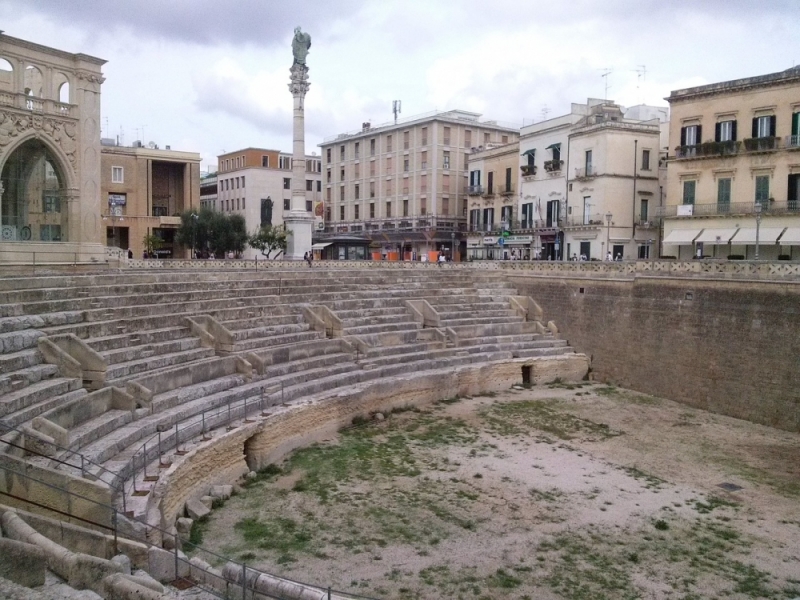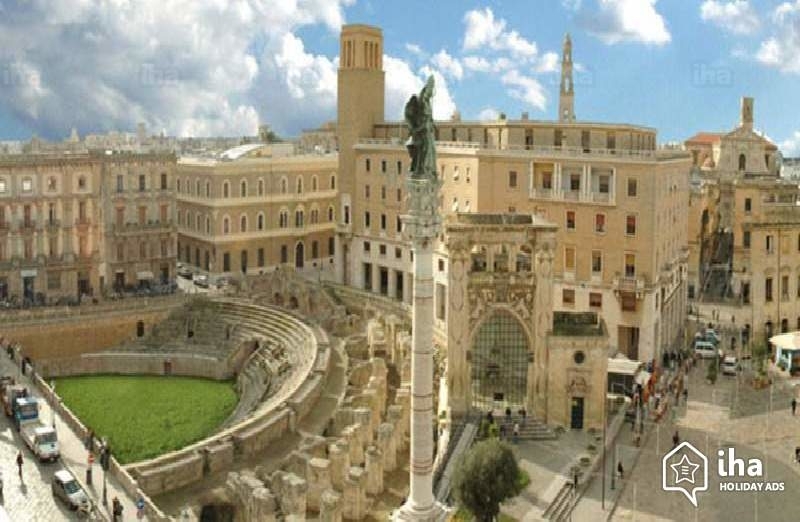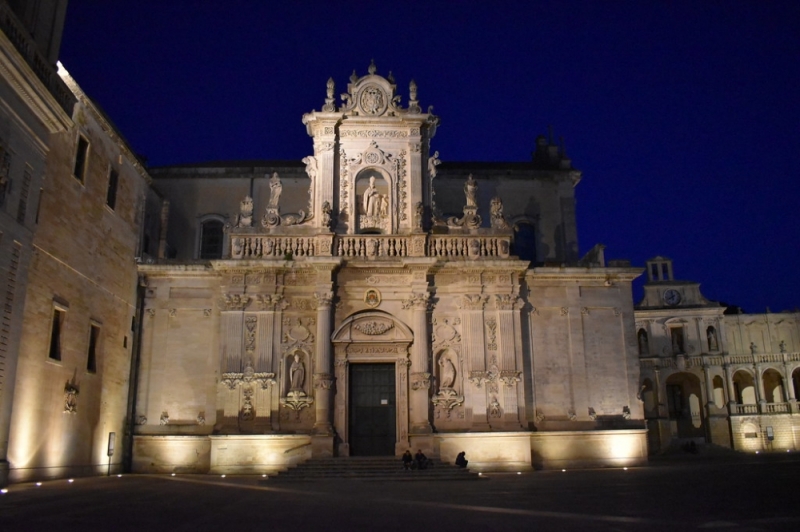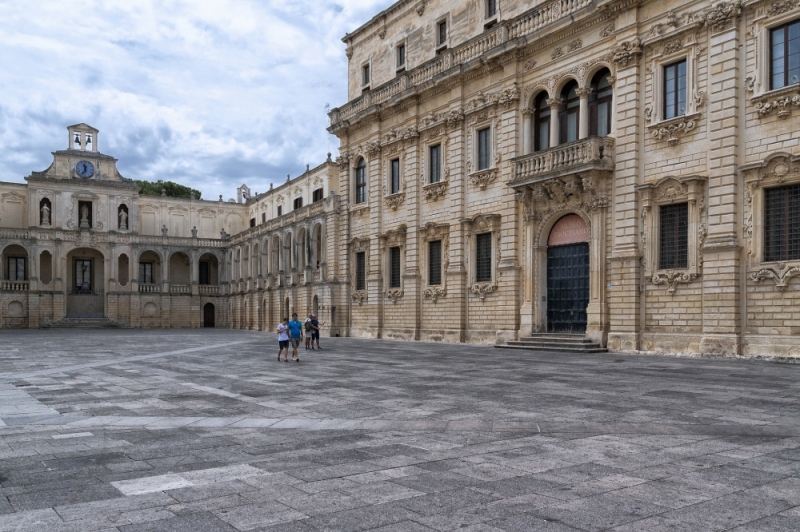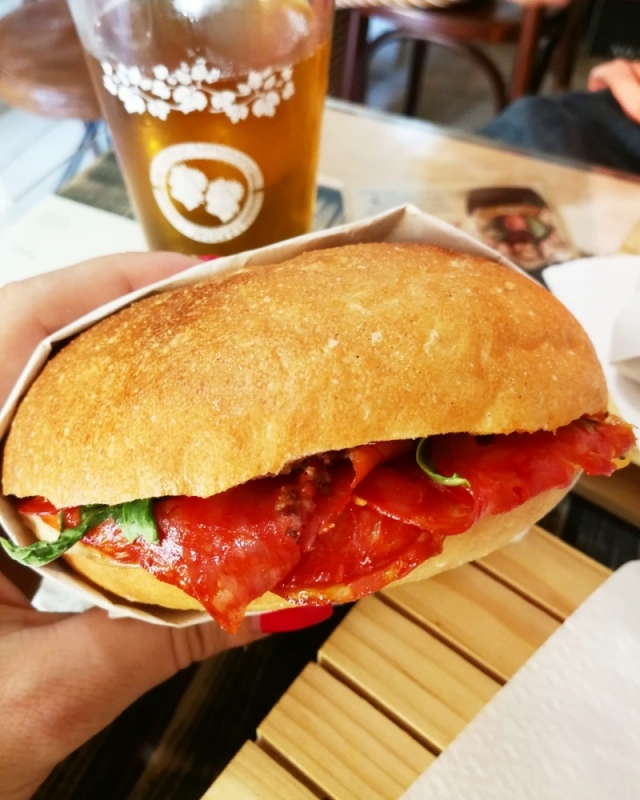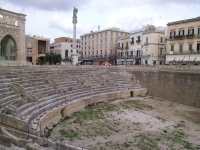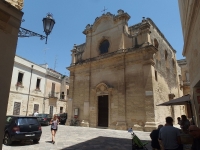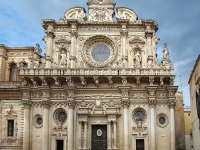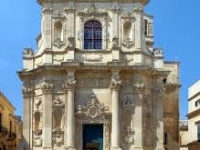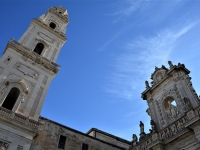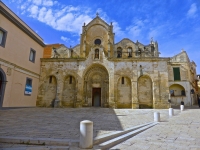Lecce and its origins
Lecce is defined as "the Florence of the south", thanks to its typically seventeenth-century architectural appearance. It is a city of very ancient origins and, throughout history, has had two flourishing periods: that of the Roman era and that of the Kingdom of Naples. Precisely in this period the city had its architectural development, to the point of taking the name "Leccese baroque". Municipality of Puglia and provincial capital, it is located almost in the center of Salento. For centuries it was the subject of dispute between the Byzantines, Lombards and Arabs and since the death of Otto II in 983, it remained in the possession of the Byzantines who made it a center of Greek cultural and religious life. It was later conquered by the Normans, who made it a county in the second half of the 11th century. Frederick II donated it to Manfredi and under the rule of the Angevins it became a fiefdom of the Brienne and the Duke of Athens surrounded it with walls. In 1353 it passed to the Enghien and then to the Orsini. During the 15th century, the city had a period of flourishing, being the hub of Florentine, Venetian, Genoese, Greek and Albanian merchants. It was around the middle of the 16th century. which became a fortress of the Spanish, who were defeated by the popular revolution of 1647. In 1848 the liberals of Lecce formed a provisional government and signed the memorandum of the confederate provinces of 12 June. The characteristic appearance of the city is due to its numerous baroque buildings in Lecce stone, a whitish or yellowish limestone, which is frequently found in the Salento peninsula. The Baroque era, which ran from the 16th to the early 18th century, was also important thanks to the work of stonecutters who decorated the buildings and also thanks to the use of Lecce stone, which was very malleable.
What see
As I have already written, Lecce is called the "Lady of the Baroque". In fact the historical center is characterized by spiers, portals, churches, monuments all in Baroque style. The city can be accessed through the Porta Napoli, built in 1548 in honor of Charles V. From here you can admire some of the city's streets, overlooked by baroque style buildings and craft shops. Walking through the streets of the center you will see the Church of Santa Maria della Provvidenza and that of Santa Maria di Costantinopoli. In Via Umberto I you will find the sixteenth century Palazzo Adorno and the Basilica of Santa Croce. Continuing your tour you will reach the city center, namely Piazza Sant'Oronzo and Piazza del Duomo, where you can admire the side façade of its Cathedral and its bell tower, the fifteenth century palazzo of the Vescovado and the Palazzo del Seminario, dating back to 1700 to today home to the Diocesan Museum of Sacred Art, the Innocenziana Library and the Diocesan Historical Archive. Between piazza Mazzini and piazza Sant'Oronzo, we find the nineteenth-century Communal Villa of Lecce, which was once called "Villa della Lupa" because inside it there was a cage in which wolves were locked up.
Roman amphitheater
Together with the Theater (in via Arte della Cartapesta), the Roman amphitheater is the most important testimony of Roman times. It was built in the 2nd century AD to entertain its spectators. The structure was buried by rubble after earthquakes and devastation but was brought to light at the beginning of the 20th century. thanks to some excavation works, it has been recovered. The part we can admire today is only one third of the entire structure. The Roman Amphitheater was built with tufa pillars surmounted by an arched architecture. Among the sculptures recovered we find: a statue of the Goddess Athena and some marble reliefs of the parapet that separated the two series of steps depicting hunting scenes and fighting between men and wild animals. The Castle of Charles V in Lecce is located in Piazza Oronzo and was commissioned by the king in 1539. It was designed by the architect and the Chapel of the Holy Trinity and the Celestine Monastery of Santa Croce were demolished. The Castle was built on a pre-existing fortification built between the 13th and 14th centuries. and is formed by two concentric structures separated by an intermediate courtyard, four angular bastions with lanceolate points, mighty walls and a moat filled in 1872. It was used for a long time for the defense of the territory, while today it is the seat of the Department of culture.
Piazza Sant'Oronzo
Piazza Sant'Oronzo is the main square of Lecce, and has always been a meeting place. It is surrounded by cafes, shops and offices, and its pavement is enriched by a mosaic depicting the city's coat of arms: the she-wolf under a Leccio tree and the crown with 5 towers. The buildings that make up the square, built between the Middle Ages and the nineteenth century, are a fusion of different styles, but they coexist harmoniously. In the past it was the "Piazza dei Mercanti", thanks to the rich presence of shops and commercial activities, which however disappeared, to make room for the building that should have been the seat of the Bank of Italy. In 1656, the square honored the patron saint of the city: in fact it is said that during the plague epidemic that struck the kingdom of Naples, Lecce was spared thanks to the mediation of Oronzo. To thank him, the people of Lecce built a 29-meter votive column on the square, on which the statue of the saint was placed in the blessing of the city. In the square there are also the remains of the Roman Amphitheater and the Sedile, also known as Palazzo del Seggio (1592), former seat of the Town Hall but currently home to art exhibitions and exhibitions. On the side of the Seat there is the ancient Church of San Marco, dating back to the XVI century. created by a Venetian colony. Opposite the Roman Amphitheater is the church of Santa Maria della Grazia, built in the Baroque period, dating back to the 16th century.
What see
Also in Piazza Sant'Oronzo there is the Castle of Lecce , also known as the Castle of Charles V, since it was restored thanks to the latter. The king, in 1539, transformed the castle into a military fortress so that he could resist the attacks of the Turks. The Duomo is located in the square of the same name and represents the symbol of the religious life of the city. The cathedral was built in 1144 to pay homage to Maria SS. Assunta, it was restored in 1230 and then rebuilt in 1659 by Giuseppe Zimbalo. The Duomo has two entrances: the main entrance, facing the bishop's palace and the secondary entrance, on the left side, facing the entrance to the Piazza. The main façade, on which there are statues of saints Gennaro and Ludovico and of the apostles Peter and Paul, appears simpler than the secondary façade, which is more opulent, being of Baroque style. The interior space is divided into three naves, separated by semi-columned pillars. In the wooden ceiling of the central nave, there are works by Giuseppe di Brindisi, such as "Il Martirio di Sant'Oronzo" and "L'Ultima Cena". The Basilica of Santa Croce together with the Convento dei Celestini, is one of the greatest examples of Baroque in Lecce. It was commissioned by the religious order of the Celestines, and the major Salentine architects such as Riccardi, Penna and Zimbalo participated in its construction. The result is a fusion of Renaissance and Baroque elements, in total harmony. The façade is composed of three parts: the lower part, in Renaissance style, is divided by six smooth columns with zoomorphic capitals, which support an entablature decorated with lions and naked-breasted women. On the main portal there is the coat of arms of Philip III of Spain. On the second part of the façade there is a majestic central rose-window, of Romanesque style and on its sides there are two niches with the statues of San Benedetto and San Celestino. On the top there is the tympanum with the triumph of the Cross at its center.
Sigismondo Castromediano Provincial Museum - Santa Chiara - Conservatory
The Sigismondo Castromediano Provincial Museum is the oldest museum in all of Puglia. Admission is free and inside you can admire finds from the Salento area. The museum owes its name to the Duke Sigismondo Castromediano, who had it built in 1868.
Not far from the Basilica of Santa Croce, there is the Church of San Nicolò dei Greci. It was built in 1765, in full neoclassical style, for Greek and Albanian merchants who lived in Lecce and incorporates the remains of a Romanesque church. Inside, Greek-Orthodox ceremonies are still held today. The Church of Santa Chiara in Piazza Vittorio Emanuele II is also worth a visit. On the façade there are plant motifs that wrap around the emblem of the order of the Clarisse. Convitto Palmieri has reopened its doors after five years of restoration. Inside the Franciscan building, there are multimedia reading rooms, a large garden and restored cloisters and courtyards. The former conservatory of Sant'Anna is a building that is not present in all travel guides. At the time it housed the Lecce women who retired to private life. In his courtyard there is a giant ficus which is 500 years old.
Not far from the Basilica of Santa Croce, there is the Church of San Nicolò dei Greci. It was built in 1765, in full neoclassical style, for Greek and Albanian merchants who lived in Lecce and incorporates the remains of a Romanesque church. Inside, Greek-Orthodox ceremonies are still held today. The Church of Santa Chiara in Piazza Vittorio Emanuele II is also worth a visit. On the façade there are plant motifs that wrap around the emblem of the order of the Clarisse. Convitto Palmieri has reopened its doors after five years of restoration. Inside the Franciscan building, there are multimedia reading rooms, a large garden and restored cloisters and courtyards. The former conservatory of Sant'Anna is a building that is not present in all travel guides. At the time it housed the Lecce women who retired to private life. In his courtyard there is a giant ficus which is 500 years old.
Abbey of Santa Maria di Cerrate
The Abbey of Santa Maria di Cerrate is an example of Salento Romanesque architecture and is located on the main road that connects Squinzano to Casalabate. Legend has it that the abbey was built around the 12th century. by order of Tancredi d'Altavilla in the exact place where he had a vision and saw the Madonna between the horns of a hind. It was an important religious center until 500, but was subsequently sacked and left in a state of disrepair until the restoration in 1965. Despite the damage, the abbey has still preserved its beauty and today is part of the assets protected by the Italian Environment Fund . Palazzo Marrese is the most beautiful building on Via Palmieri: it dates back to the 18th century. and has a door framed by four female caryatids. In Lecce there are three monumental gates , which represent the historical entrances of the ancient urban nucleus: Porta Rudiae, it was built in 1703 and on it is the statue of Sant'Oronzo in addition to the busts of the city; Porta Napoli was built in 1548 in anticipation of the visit of Charles V; finally there is Porta San Biagio, probably the most elegant, which has smooth columns and the Latin inscription. Near Porta San Biagio there is a little-known museum: the Faggiano Museum. It has this name since in 2001 Luciano Faggiano, the owner of the building, broke the floors to change the old sewer pipes and there he found the remains of various eras. In Lecce there is the main theater, the Politeama Greco , and then there is a small theater called Teatro Paisiello, a neoclassical theater that hosts the Maggio Musicale Salentino every year. It owes its name to the Tarantino musician and its inauguration dates back to 1870, on the occasion of Verdi's Masquerade Ball. Lecce is also called "the city of churches". In addition to the Duomo and the Basilica of Santa Croce, there are about 40 churches scattered around the city. Among the most ancient there is the Church of the Saints Nicolò and Cataldo in the cemetery of the city, built in 1180. Among the most original there is instead the Church of San Matteo, with its curved facade that recalls the Roman church of San Carlo alle Quattro Fountains.
Movida and entertainment
Lecce is a city of a thousand faces. To its baroque facade, a pulsating heart is added that lights up at night. The city center is the "via della movida" and starts from Porta San Biagio. One of the most typical dishes of Salento is undoubtedly the puccia leccese . If you want to try one, we recommend the Corner of Via Matteotti, a few steps from Piazza San Carlo or even the local "La Puccia", in Viale Giacomo Leopardi, which offers a puccia with genuine ingredients, at reasonable prices. A place that represents a fixed stop for the people of Lecce, is Route 66 , a steak house and texan food house, in an informal setting where every Thursday there is a beer festival. In Piazzetta Santa Chiara there are the Urban Cafè or the Alibi Cafè, both a short walk from Piazza Sant'Oronzo. In these places you can listen to music and enjoy some street food. The Black Betty is among the most popular clubs in the city: it is both a live music pub and a brewery and is suitable for all tastes, in fact there are the live art room, the taste room and the relax room. In via Libertini, instead, there is a delightful restaurant, named Boccon Divino, which also has tables on the street. There you can taste typical dishes, such as buffalo mozzarella with hot croutons and raw marmalade. Also worth trying is the Tennent's Grill, an Anglo-Saxon style pub that offers a menu for celiacs and families and lots of beers to taste. In via Paladini there is one of the most popular places for young people, the Coffeeandcigarettes which is a bistro, a cocktail bar and an internet cafe. The venue is home to jazz, groove, swing concerts and also hosts international artists. If after dinner or aperitif you want to go wild on the track, going towards Novoli, there is Area 51, one of the most famous discopubs in the area. You can dance to contemporary, techno, house, commercial and Latin American music.
Night of the Taranta
In Surbo instead there is the Boogaloo, a place suitable for lovers of Latin American music, so much so as to be nicknamed "Casita de la Salsa". During the summer, the nightlife focuses on the Adriatic and Ionian coast with lots of elegant and glamorous seaside restaurants. If you want to try the renowned Quarta coffee, we recommend a historic café in the heart of Lecce, the Avio bar. Here you can enjoy coffee either in a hot cup or with ice. You can accompany your coffee with a pasticciotto from the Franchini pastry shop, known in Lecce, opened since 1963. If you are in the Salento more generally between the end of July and mid-August, you cannot miss the traditional " Notte della Taranta ". La Notte della Taranta is a popular music festival that aims to enhance traditional Salentine music and the traditional dance "Taranta" through its re-proposal and contamination with other musical languages. It takes place in itinerant form in various squares of Salento, starting from Corigliano d'Otranto and culminating in the Melpignano concertone with the participation of musicians of national and international fame. The festival records a participation, from 5,000 in 1998, of over 200,000 spectators in the only night of the last concert in 2019.
Climate, curiosity and advice
Climate : the climate in the city of Lecce is warm and temperate. The coldest month is January, with a temperature of + 11.7 ° C, while the hottest month is August, with an average temperature of + 29.7 ° C. Average annual rainfall occurs in autumn, with minimal rainfall in the summer.
Curiosity: the papier-mâché works are perhaps the main aspect of the Lecce craftsmanship. The first example dates back to 1782, by the artisan Pietro Sorgente, who created the statue of San Lorenzo. There is a famous legend concerning a beautiful girl who was guilty of having loved a young Saracen who had landed in the city during a raid. The young woman had had a child with him but she was so mad that she threw the child into the waves. For many nights her son's cry called her from the stormy sea, until she, in desperation, threw herself from the cliff. This is why it is said that during the windy winter nights, the cry of pain of the child resounds, along with the cries of remorse of the mother.
Tips: if you want to reach the city by train, you can book with Trenitalia. From Bari station it takes more or less an hour and forty, while from Brindisi station no more than thirty minutes. If you prefer to arrive by plane, there are both Bari and Brindisi airports.
For those traveling by car, just keep reference A14 Bologna-Taranto and take the Bari Sud exit.
For those traveling by car, just keep reference A14 Bologna-Taranto and take the Bari Sud exit.


